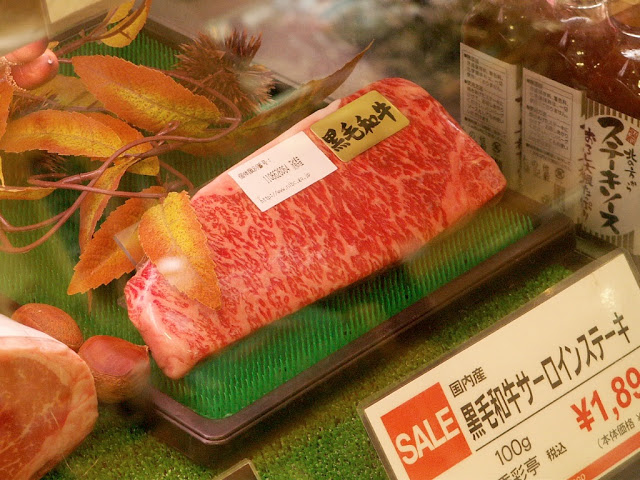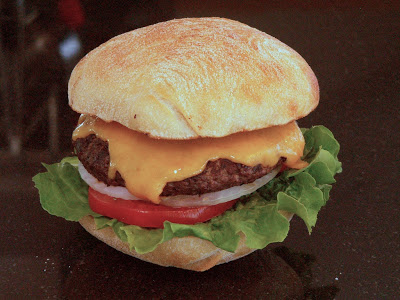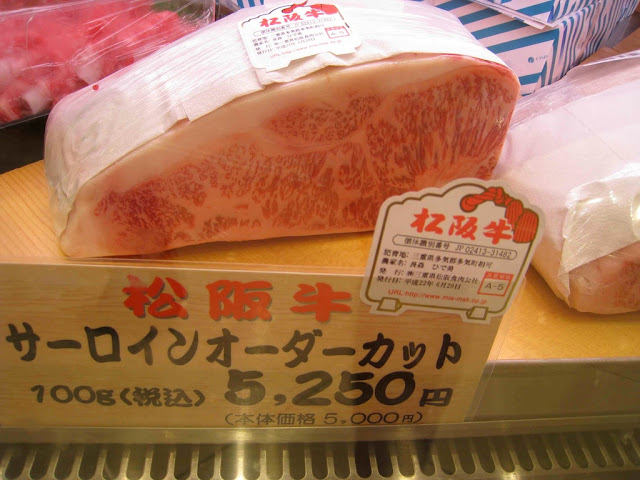First off, this is not a basketball story! Here in Colorado we care more about great beef than the Laker’s shooting guard, and besides, we’re Nugget’s fans! Kobe Beef confuses most folks, and rightly so, it’s a complicated subject! I’ll try to simplify it here…
Why Eat Kobe or Kobe-style Wagyu Beef?

Wagyu beef in a Japanese supermarket
Taste and Tenderness
Japanese KobeBeef / Wagyu and American Wagyu Beef are famous among beef aficionados for their exceptional flavor, juiciness and tenderness. Generously marbled and aged, Wagyu Beef (‘Wa’ means Japanese, ‘gyu’ means beef) is a fabulous experience for the beef lover.
Washington State University, has conducted extensive research and the Wagyu breed consistently outperformed other breeds of the same grade. Laboratory tests rate it as tender to more tender, and taste panels judge it superior in taste, tenderness and juiciness. Taste testing is subjective, so why not conduct your own side-by-side tasting! It makes for a fun and tasty evening!

Kobe steaks seared on the teppan, Yokohama Sheraton
Healthy Fats and Low Cholesterol
Not only does Wagyu beef taste great, it fits into a low cholesterol diet thanks to healthier fats! With a high percentage of oleaginous unsaturated fats, omega-3 and omega-6 fatty acids, and increased ratio of monounsaturated – saturated fats.
Tony’s Kobe-style Wagyu Beef

Kobe patties prepared teppan style in Xex, a Morimoto-san (of Iron Chef fame) restaurant in Tokyo.
Our Kobe-style Wagyu Beef is raised in the USA ranging freely on grasses and finished with grain. The cattle will never have been administered growth hormones or antibiotic growth promotants and are humanely raised in strict accordance with the Holistic Management International model to produce high-quality meats while improving the land where the animals graze.

Great Burgers!
Tony’s most popular selling Kobe-style beef item is ground beef patties. Burger lovers truly appreciate the amazing flavor and juiciness; ask for them in our meat department. Additionally they also make amazing Salisbury steak and meatballs with your favorite recipes.
Kobe Burger with Horseradish and Bacon
Cooking Kobe-style Beef
Generally speaking Kobe-style beef steaks and patties are best cooked on the grill, in a grill pan or in a skillet over medium heat – just a little lower and slower than usual.
Grilling:

Thin slices of Kobe loin, marinated and cooked over medium coals on a Korean BBQ grill.
Start with a preheated indirect grill – with medium to medium high heat on one side and low to no heat on the other. Brown both sides over direct heat and move to very low – no heat and close the lid to finish cooking – rare to medium rare is suggested for steaks. Remove from grill to a plate, cover and rest for 10 minutes before serving with or without the reserved drippings.

Wagyu on a hot rock ‘Ishiyaki-style’ in Kyoto
Personally I prefer a more Japanese approach to Wagyu steaks, I like to slice them thin and marinade in teriyaki (or something similar) and then brown them briefly over medium high coals on a indoor grill, eating them right off the grill as they finish. This is a fun and very social way to serve.
Shabu Shabu:

Just a couple ounces of beef is served with lots of veggies – Shabu Shabu with high grade Wagyu in Japan
Shabu Shabu is a very popular Japanese dish where the beef is sliced paper thin and dipped / swished in boiling water for just a couple seconds before eating with your choice of sauce. Veggies are then cooked in the boiling water and finally noodles to finish with a nice soup – pictured below. Learn more about Shabu Shabu here
Sukiyaki:
is another great use for Wagyu, the meats are cooked in a hot pot with veggies and dipped into raw egg – a delicious and very Japanese approach to savoring small quantities of this treasured beef – below.

Briefly cooked in a sweet stock and dipped in raw egg – sheer heaven! If you want to try this, I suggest coddling the eggs in boiling water for 3-4 minutes; use the hot yolks for dipping and the whites in salad.
Japanese VS American Wagyu
Generally here in the states folks loosely use the term ‘Kobe Beef’ when referring to meats from the Japanese Wagyu cattle breeds. Technically, Kobe is a trademarked name with many strict restrictions, and none has been imported into the United States since 2010. Kobe is the most well known of four major regions of fine beef production in Japan.

Two grades of Wagyu beef, the one on the left is very close to American Kobe-style Wagyu Beef
Japanese Kobe / Wagyu is kept on feed its entire life, and raised to an older age to achieve extreme levels of marbling. Premium Wagyu is usually served shabu-shabu style; sliced paper thin and swished in boiling water for a few seconds – and it tastes like butter! If you put a thick cut of Kobe beefsteak on the grill, it would act a lot like a stick of butter – melting and catching fire!

A-5 grade Matsutaka wagyu in Japan, about $300 /LB 5 years ago – so small portions are the rule!
Beer and Massages?
Japanese ranchers are known to give their animals beer to keep their appetite strong during the hot months. These cattle are also often massaged and brushed with sake to reduce stress and improve the coat, because happy animals are thought to be the best tasting. American ranchers might not break out the beer and massages, however every rancher I’ve ever met agrees about the happiness of their herds and treat their animals with the utmost kindness and respect.

Shoulder cuts from a prize Wagyu beef at a very popular Korean Grill restaurant in Japan.
American Kobe-style Wagyu Beef
…has been crossbred with prize Angus beef to create a hybrid more suitable to our climate and cooking style. The animals are range fed on grass and finished on a mixture of corn, alfalfa, barley and wheat straw to emulate the Japanese feed blend and produce beef with great marbling and flavor that performs beautifully on the grill.

Comments are closed.

